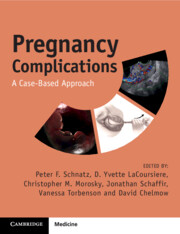Book contents
- Pregnancy Complications
- Pregnancy Complications
- Copyright page
- Contents
- Contributors
- Preface
- Note from the Editor-in-Chief
- Normal Laboratory Values (Conventional Units) []
- Section 1 Antepartum (Early Pregnancy)
- Section 2 Antepartum (Mid-trimester)
- Section 3 Antepartum (Late Pregnancy)
- Section 4 Antepartum (Medical Complications)
- Section 5 Antepartum (Infectious Complications)
- Section 6 Intrapartum/Delivery
- Section 7 Postpartum
- Case 63 A 20-Year-Old with Vaginal Bleeding and Enlarging Fundus Following a Cesarean Delivery
- Case 64 A 25-Year-Old with Post-cesarean Endometritis and Fever Unresponsive to Antibiotics
- Case 65 A 40-Year-Old with Severe Obesity and Painful Right Pedal Edema
- Case 66 A 20-Year-Old 3 Weeks’ Postpartum Presents with Anhedonia and Insomnia
- Case 67 A 40-Year-Old 1 Week after Vaginal Delivery Presents with Shortness of Breath and Orthopnea
- Case 68 A 30-Year-Old with Postural Headache 12 Hours after a Vaginal Delivery with Use of an Epidural
- Case 69 A 35-Year-Old Develops Agitation, Dyspnea, Hypotension, and Cardiovascular Collapse Immediately Postpartum
- Case 70 A 25-Year-Old Presents with Bright Red Vaginal Bleeding 3 Weeks’ Postpartum
- Case 71 A 25-Year-Old Presents Immediately Postpartum with Severe Pubic Pain Limiting Ambulation
- Case 72 A 20-Year-Old with Right Breast Pain and Fever while Breast-Feeding
- Case 73 A 25-Year-Old 6 Hours’ Postpartum with Severe Hypertension, Seizures, and Confusion
- Section 8 Fetal Complications
- Section 9 Placental Complications
- Section 10 Complications of the Cord, Amnion, and Gravid Uterus
- Section 11 Psychosocial Considerations
- Index
- References
Case 72 - A 20-Year-Old with Right Breast Pain and Fever while Breast-Feeding
from Section 7 - Postpartum
Published online by Cambridge University Press: 08 April 2025
- Pregnancy Complications
- Pregnancy Complications
- Copyright page
- Contents
- Contributors
- Preface
- Note from the Editor-in-Chief
- Normal Laboratory Values (Conventional Units) []
- Section 1 Antepartum (Early Pregnancy)
- Section 2 Antepartum (Mid-trimester)
- Section 3 Antepartum (Late Pregnancy)
- Section 4 Antepartum (Medical Complications)
- Section 5 Antepartum (Infectious Complications)
- Section 6 Intrapartum/Delivery
- Section 7 Postpartum
- Case 63 A 20-Year-Old with Vaginal Bleeding and Enlarging Fundus Following a Cesarean Delivery
- Case 64 A 25-Year-Old with Post-cesarean Endometritis and Fever Unresponsive to Antibiotics
- Case 65 A 40-Year-Old with Severe Obesity and Painful Right Pedal Edema
- Case 66 A 20-Year-Old 3 Weeks’ Postpartum Presents with Anhedonia and Insomnia
- Case 67 A 40-Year-Old 1 Week after Vaginal Delivery Presents with Shortness of Breath and Orthopnea
- Case 68 A 30-Year-Old with Postural Headache 12 Hours after a Vaginal Delivery with Use of an Epidural
- Case 69 A 35-Year-Old Develops Agitation, Dyspnea, Hypotension, and Cardiovascular Collapse Immediately Postpartum
- Case 70 A 25-Year-Old Presents with Bright Red Vaginal Bleeding 3 Weeks’ Postpartum
- Case 71 A 25-Year-Old Presents Immediately Postpartum with Severe Pubic Pain Limiting Ambulation
- Case 72 A 20-Year-Old with Right Breast Pain and Fever while Breast-Feeding
- Case 73 A 25-Year-Old 6 Hours’ Postpartum with Severe Hypertension, Seizures, and Confusion
- Section 8 Fetal Complications
- Section 9 Placental Complications
- Section 10 Complications of the Cord, Amnion, and Gravid Uterus
- Section 11 Psychosocial Considerations
- Index
- References
Summary
This case reviews the presentation, diagnosis, and treatment of lactation mastitis. New clinical evidence suggests that lactation mastitis is a spectrum of disorders due to underlying inflammation and edema of the mammary gland. Persistent untreated inflammation can lead to bacterial mastitis, galactocele, phlegmon, or abscess formation. A focused history and physical examination are necessary to identify the specific cause of symptoms and target therapy. Current evidence shows that early identification of mastitis and timely treatment of underlying inflammation can help reduce unnecessary antibiotic use and prevent progression to more severe disease.
- Type
- Chapter
- Information
- Pregnancy ComplicationsA Case-Based Approach, pp. 221 - 223Publisher: Cambridge University PressPrint publication year: 2025

